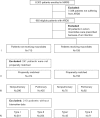Macrolide therapy is associated with reduced mortality in acute respiratory distress syndrome (ARDS) patients
- PMID: 29430441
- PMCID: PMC5799146
- DOI: 10.21037/atm.2017.12.25
Macrolide therapy is associated with reduced mortality in acute respiratory distress syndrome (ARDS) patients
Abstract
Background: Macrolides have been associated with favorable immunological effects in various inflammatory disease states. We investigated the association between macrolide therapy and mortality in patients with the acute respiratory distress syndrome (ARDS).
Methods: This was an unplanned secondary analysis of patients with ARDS within a large prospective observational study of critically ill patients in the intensive care units (ICUs) of two university-affiliated hospitals in the Netherlands. The exposure of interest was low-dose macrolide use prescribed for another reason than infection; we excluded patients who received high-dose macrolides for an infection. The primary endpoint was 30-day mortality. The association between macrolide therapy and mortality was determined in the whole cohort, as well as in a propensity score matched cohort; the association was compared between pulmonary versus non-pulmonary ARDS, and between two biological phenotypes based on plasma levels of 20 biomarkers.
Results: In total, 873 patients with ARDS were analyzed, of whom 158 patients (18%) received macrolide therapy during stay in ICU for a median duration of 3 (interquartile range, 1-4) days. Erythromycin was the most frequent prescribed macrolide (97%). Macrolide therapy was associated with reduced 30-day mortality in the whole cohort [22.8% vs. 31.6%; crude odds ratio (OR), 0.64 (interquartile range, 0.43-0.96), P=0.03]. The association in the propensity score matched cohort remained significant [22.8% vs. 32.9%; OR, 0.62 (interquartile range, 0.39-0.96), P=0.03]. Propensity matched associations with mortality were different in patients with non-pulmonary ARDS vs. pulmonary ARDS and also varied by biological phenotype.
Conclusions: These data together show that low-dose macrolide therapy prescribed for another reason than infection is associated with decreased mortality in patients with ARDS.
Keywords: Acute respiratory distress syndrome (ARDS); erythromycin; macrolide; mortality; phenotypes; propensity score.
Conflict of interest statement
Conflicts of Interest: The authors have no conflicts of interest to declare.
Figures
Similar articles
-
Usefulness of β-lactam and macrolide combination therapy for treating community-acquired pneumonia patients hospitalized in the intensive care unit: Propensity score analysis of a prospective cohort study.J Infect Chemother. 2021 Oct;27(10):1447-1453. doi: 10.1016/j.jiac.2021.06.003. Epub 2021 Jun 17. J Infect Chemother. 2021. PMID: 34147355
-
Plasma surfactant protein-D as a diagnostic biomarker for acute respiratory distress syndrome: validation in US and Korean cohorts.BMC Pulm Med. 2017 Dec 15;17(1):204. doi: 10.1186/s12890-017-0532-1. BMC Pulm Med. 2017. PMID: 29246207 Free PMC article.
-
Epidemiology and patterns of tracheostomy practice in patients with acute respiratory distress syndrome in ICUs across 50 countries.Crit Care. 2018 Aug 17;22(1):195. doi: 10.1186/s13054-018-2126-6. Crit Care. 2018. PMID: 30115127 Free PMC article.
-
Macrolide-based regimens in absence of bacterial co-infection in critically ill H1N1 patients with primary viral pneumonia.Intensive Care Med. 2013 Apr;39(4):693-702. doi: 10.1007/s00134-013-2829-8. Epub 2013 Jan 24. Intensive Care Med. 2013. PMID: 23344833 Free PMC article.
-
Antioxidants as Therapeutic Agents in Acute Respiratory Distress Syndrome (ARDS) Treatment-From Mice to Men.Biomedicines. 2022 Jan 4;10(1):98. doi: 10.3390/biomedicines10010098. Biomedicines. 2022. PMID: 35052778 Free PMC article. Review.
Cited by
-
Two Cases of Severe COVID-19 Pneumonia Effectively Treated with Extracorporeal Membrane Oxygenation in Addition to Favipiravir and Corticosteroid.Intern Med. 2021;60(1):123-130. doi: 10.2169/internalmedicine.5475-20. Epub 2021 Jan 1. Intern Med. 2021. PMID: 33390469 Free PMC article.
-
Hydroxychloroquine vs. Azithromycin for Hospitalized Patients with COVID-19 (HAHPS): Results of a Randomized, Active Comparator Trial.Ann Am Thorac Soc. 2020 Nov 9;18(4):590-7. doi: 10.1513/AnnalsATS.202008-940OC. Online ahead of print. Ann Am Thorac Soc. 2020. PMID: 33166179 Free PMC article.
-
Anti-inflammatory activity of lefamulin versus azithromycin and dexamethasone in vivo and in vitro in a lipopolysaccharide-induced lung neutrophilia mouse model.PLoS One. 2021 Sep 29;16(9):e0237659. doi: 10.1371/journal.pone.0237659. eCollection 2021. PLoS One. 2021. PMID: 34587166 Free PMC article.
-
Effect of erythromycin on mortality and the host response in critically ill patients with sepsis: a target trial emulation.Crit Care. 2022 May 24;26(1):151. doi: 10.1186/s13054-022-04016-x. Crit Care. 2022. PMID: 35610649 Free PMC article.
-
Azithromycin does not improve disease severity in acute experimental pancreatitis.PLoS One. 2019 May 10;14(5):e0216614. doi: 10.1371/journal.pone.0216614. eCollection 2019. PLoS One. 2019. PMID: 31075097 Free PMC article.
References
-
- Yamamoto M, Kondo A, Tamura M, et al. Long--term therapeutic effects of erythromycin and newquinolone antibacterial agents on diffuse panbronchiolitis. Nihon Kyobu Shikkan Gakkai Zasshi 1990;28:1305-13. - PubMed
-
- Kudoh S, Uetake T, Hagiwara K, et al. Clinical effects of low--dose long--term erythromycin chemotherapy on diffuse panbronchiolitis. Nihon Kyobu Shikkan Gakkai Zasshi 1987;25:632-42. - PubMed
LinkOut - more resources
Full Text Sources
Other Literature Sources

